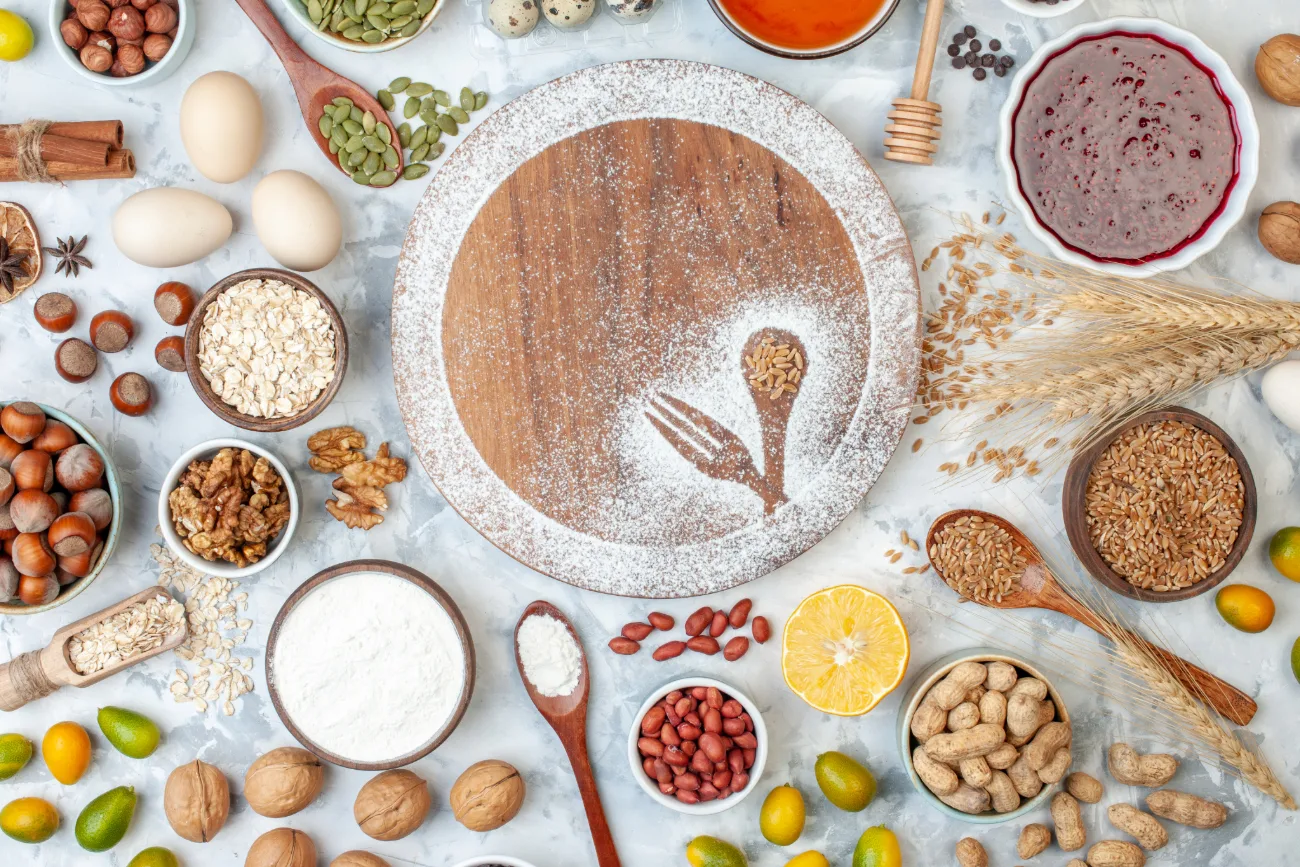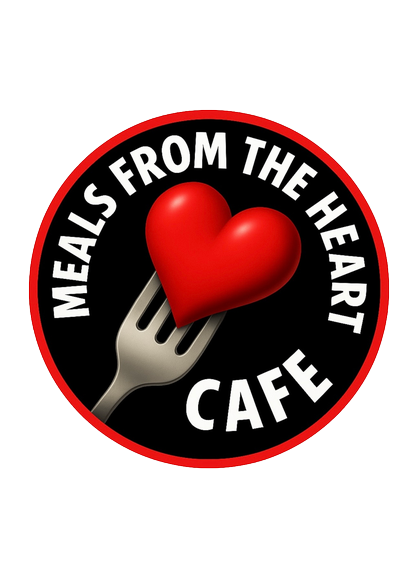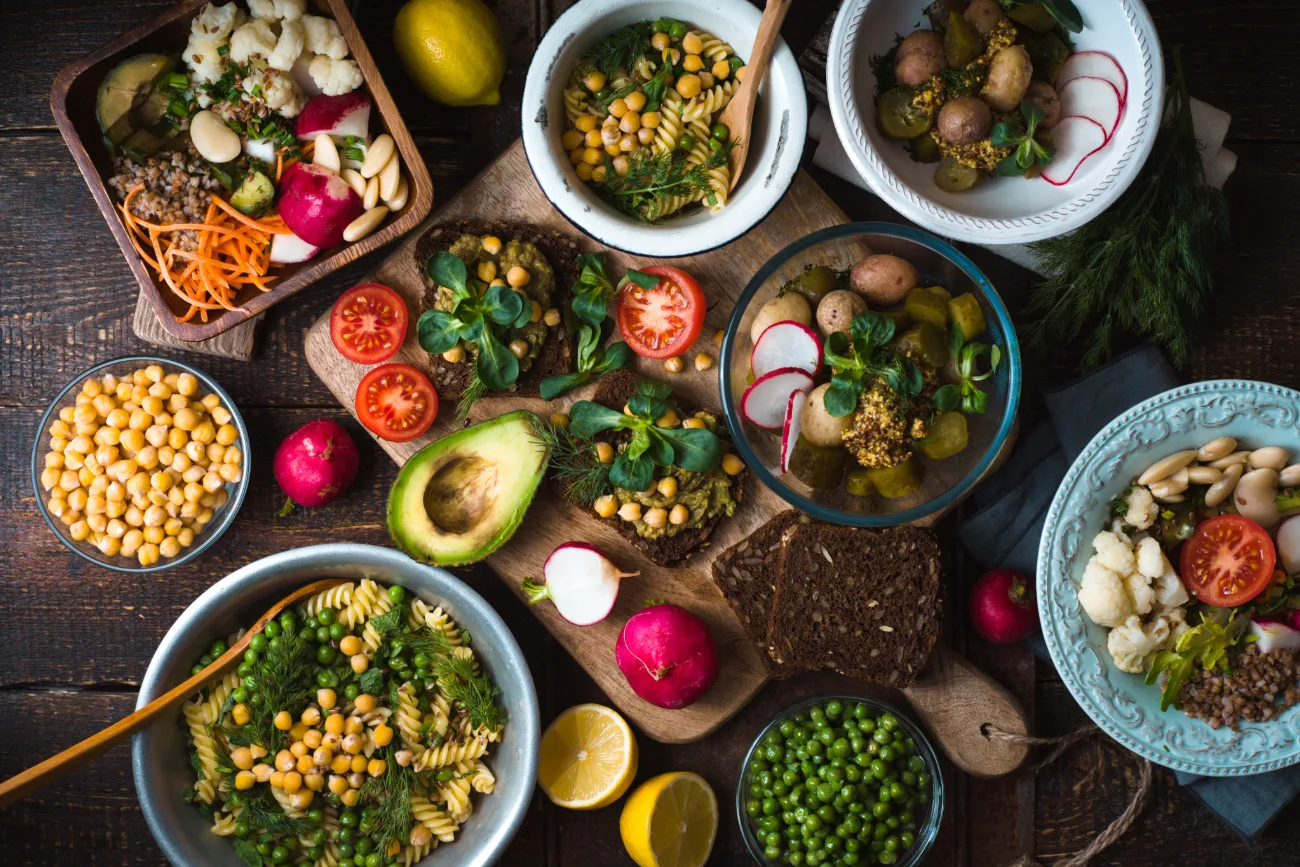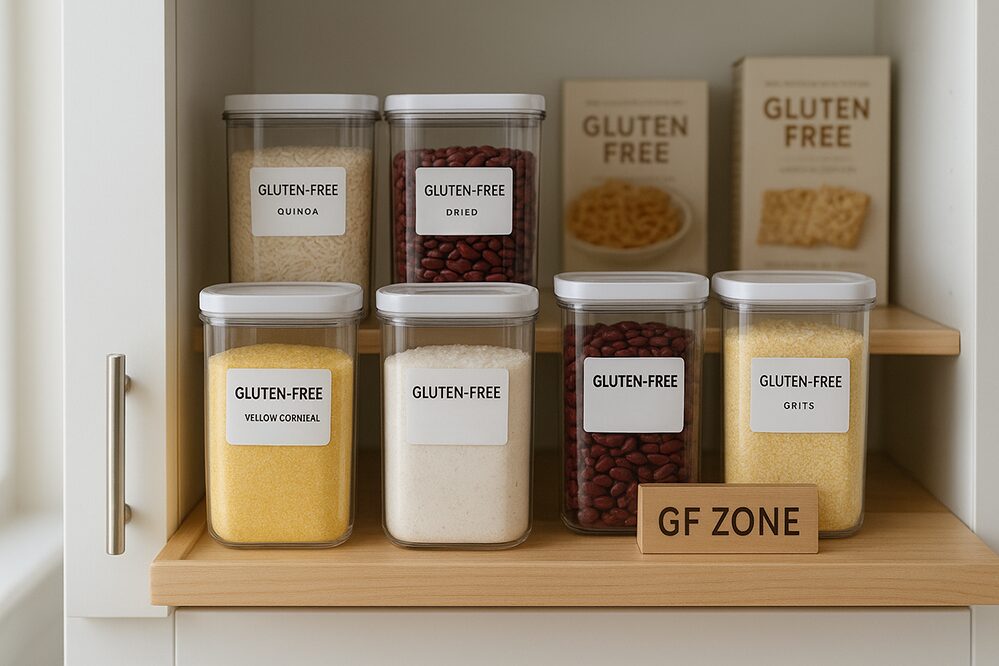
Gluten has become a buzzword in the world of nutrition and health, but what exactly is it, and why does it matter?
Whether you’re exploring a gluten-free diet due to health concerns or simply curious about gluten’s role in your food, this article will break it all down for you. From understanding what gluten is to navigating gluten-free living, this article will provide the answers you need to make informed choices about your diet.
What Is Gluten?
Gluten is a protein found in certain cereal grains, including wheat, barley, and rye. It’s made up of two main proteins: glutenins and gliadins. When these proteins mix with water, they form a sticky network that gives bread dough its elasticity and helps baked goods rise. This unique property makes gluten a superstar in the culinary world, especially in foods like bread, pasta, and pastries.
But gluten protein isn’t just in baked goods. It’s also used as a stabilizing agent in many processed foods, such as ice cream, ketchup, and even soy sauce. You might be surprised to learn that gluten is also found in beer and some cosmetics. Its versatility makes it a common ingredient in many products, but for some people, gluten can cause serious health issues.
What Is Wheat Gluten?
Wheat gluten is a specific type of gluten found in wheat, barley, and rye. It’s the primary protein in wheat and is responsible for the elasticity and chewiness in baked goods like bread and pizza dough. Wheat gluten is often extracted and used as a standalone ingredient in vegetarian and vegan products, such as seitan, which is a popular meat substitute.
Wheat gluten is also used in unexpected places, like pet foods, cosmetics, and even some hair products. Its binding and texturizing properties make it a versatile ingredient in both food and non-food industries.
Gluten and Health: The Good and the Bad
For most people, gluten is harmless and even beneficial. Whole grains like wheat, barley, and rye are packed with nutrients and have been linked to a lower risk of heart disease, stroke, and diabetes. Gluten’s ability to provide structure and chewiness to baked goods makes it a favorite among bakers and food scientists. The process of gluten development occurs when wheat flour is mixed with water and kneaded, allowing the proteins to form elastic networks that give bread its distinctive texture.
However, for others, gluten can be a source of discomfort or even serious health problems. Let’s dive into the conditions associated with gluten.
Celiac Disease: An Autoimmune Condition
Celiac disease is an autoimmune condition where the immune system mistakenly sees gluten as a threat and attacks it. This autoimmune response damages the lining of the small intestine, making it harder for the body to absorb nutrients. Over time, this can lead to malnutrition and other serious health issues.
The only treatment for celiac disease is a strict gluten-free diet. Even small amounts of gluten intake—as little as 10 milligrams per day—can cause intestinal damage. For people with celiac disease, avoiding gluten isn’t just a choice; it’s a necessity.
Non-Celiac Gluten Sensitivity (NCGS)
If you don’t have celiac disease but still feel unwell after eating gluten, you might have non-celiac gluten sensitivity (NCGS). This condition is more common than celiac disease, affecting an estimated 6-10% of people. Symptoms can range from bloating and digestive symptoms to fatigue, headaches, and even brain fog.
Interestingly, NCGS might not be caused by gluten alone. Other components in wheat, barley, and rye could also trigger symptoms. If you suspect you have NCGS, switching to a gluten-free diet might help, but it’s always a good idea to consult a healthcare professional first.
Wheat Allergy and Other Gluten-Related Issues
A wheat allergy is different from celiac disease or NCGS. It’s an allergic reaction to proteins found in wheat, not just gluten. Symptoms can include hives, difficulty breathing, and in severe cases, anaphylaxis. People with a wheat allergy need to avoid wheat but may still be able to eat other gluten-containing grains like barley and rye.
Other conditions linked to gluten include gluten ataxia, a rare neurological disorder, and dermatitis herpetiformis, a skin rash caused by gluten exposure. These conditions highlight just how complex gluten’s effects can be on the body.
What Is a Gluten-Free Diet?
A gluten-free diet eliminates all foods containing wheat, barley, and rye. This means saying goodbye to traditional bread, pasta, and baked goods—unless they’re made with gluten-free alternatives.
But going gluten-free isn’t just about cutting out certain foods; it’s also about finding safe, delicious replacements.
Naturally Gluten-Free Foods
The good news is that many foods are naturally gluten-free. These include:
- Fruits and vegetables
- Meat, fish, and poultry (unprocessed)
- Dairy products
- Rice, quinoa, and corn
- Nuts and seeds
When shopping, look for products labeled gluten-free to ensure they haven’t been cross-contaminated with gluten during processing.
Gluten-Free Substitutes
Thanks to advancements in food science, there are now plenty of gluten-free alternatives for your favorite foods. Gluten-free bread, pasta, and baked goods are widely available, though they can be pricier than their gluten-containing counterparts.
When choosing these products, opt for whole, nutrient-dense options over highly processed ones.
Managing a Gluten-Free Lifestyle
Living gluten-free can be challenging, especially when dining out or traveling. Here are some tips to make it easier:
- Read Labels Carefully: Gluten can hide in unexpected places, like sauces, dressings, and even some medications.
- Avoid Cross-Contamination: Use separate utensils, cutting boards, and toasters for gluten-free foods.
- Plan Ahead: When eating out, call ahead to ask about gluten-free options or use apps to find gluten-free restaurants.
- Focus on Whole Foods: Build your diet around naturally gluten-free foods like fruits, vegetables, and lean proteins.
International Standards and Regulations
Different countries have different rules for labeling gluten-free products. In the European Union, for example, foods labeled “gluten-free” must contain less than 20 parts per million (ppm) of gluten. In Canada, all food products must clearly indicate if they contain gluten. These regulations make it easier for people with gluten-related disorders to shop safely. For more information, visit the FDA’s guidelines on gluten-free labeling.
FAQs About Gluten and Gluten-Free Foods
What Does Gluten-Free Mean?
Gluten-free means a food contains no gluten or has a gluten content of less than 20 parts per million (ppm), which is the threshold considered safe for most people with celiac disease.
Is Rice Gluten-Free?
Yes, rice is naturally gluten-free. Whether it’s white, brown, or wild rice, you can enjoy it without worrying about gluten. Just be cautious with flavored or pre-packaged rice mixes, as they may contain gluten-containing additives.
Is Oatmeal Gluten-Free?
Pure oats are gluten-free, but they’re often cross-contaminated with gluten during processing. If you have celiac disease or gluten sensitivity, look for oats specifically labeled gluten-free to ensure they’re safe to eat.
Is Quinoa Gluten-Free?
Yes, quinoa is a naturally gluten-free grain and a great source of protein and fiber. It’s a fantastic alternative to gluten-containing grains like wheat and barley.
Are Potatoes Gluten-Free?
Yes, potatoes are naturally gluten-free. Whether you’re enjoying them mashed, baked, or fried, you don’t have to worry about gluten. Just watch out for processed potato products like fries or chips, which may contain gluten-based coatings or seasonings.
Is Sourdough Bread Gluten-Free?
Traditional sourdough bread is made from wheat, so it’s not gluten-free. However, some gluten-free sourdough options are made with alternative flours like rice or buckwheat.
Are Doritos Gluten-Free?
Most Doritos flavors contain gluten due to seasonings or additives. However, a few flavors, like Simply Organic White Cheddar, are gluten-free. Always check the label to be sure.
Are Rice Krispies Gluten-Free?
Traditional Rice Krispies contain malt flavoring, which is derived from barley and contains gluten. However, there are gluten-free versions available, so look for those if you need to avoid gluten.
What Foods Have Gluten?
Gluten is found in wheat, barley, rye, and any products made from these grains. This includes bread, pasta, baked goods, beer, and many processed foods.
Are Corn Tortillas Gluten-Free?
Yes, corn tortillas are naturally gluten-free, as long as they’re made from 100% corn. Always check the label to ensure no wheat flour has been added.
Is Cornstarch Gluten-Free?
Yes, cornstarch is naturally gluten-free and is often used as a thickening agent in soups, sauces, and desserts.
Is Couscous Gluten-Free?
No, couscous is made from wheat, so it’s not gluten-free. For a gluten-free alternative, try quinoa or rice.
Is Farro Gluten-Free?
No, farro is a type of wheat and contains gluten. If you’re looking for a gluten-free grain, opt for quinoa, millet, or buckwheat.
Is Popcorn Gluten-Free?
Yes, plain popcorn is naturally gluten-free. However, flavored or pre-packaged popcorn may contain gluten, so always check the label.
Are Grits Gluten-Free?
Plain grits made from corn are naturally gluten-free, but cross-contamination can occur during processing. Look for grits labeled gluten-free to be safe.
Are Marshmallows Gluten-Free?
Most marshmallows are gluten-free, but some brands may use gluten-containing ingredients. Always check the label to be sure.
Are Oreos Gluten-Free?
Traditional Oreos contain wheat flour and are not gluten-free. However, gluten-free versions are now available in some markets.
Is Barley Gluten-Free?
No, barley contains gluten. It’s commonly found in beer, malt products, and some soups.
Is Buckwheat Gluten-Free?
Yes, despite its name, buckwheat is naturally gluten-free and is a great alternative to gluten-containing grains.
Is Risotto Gluten-Free?
Traditional risotto is made with Arborio rice, which is gluten-free. However, some recipes or pre-packaged risotto mixes may include gluten-containing ingredients, so always check the label.
Is Soy Sauce Gluten-Free?
Traditional soy sauce is made with wheat and contains gluten. However, gluten-free soy sauce options, often labeled as tamari, are widely available.
Are Snickers Gluten-Free?
Most Snickers bars are considered gluten-free, but they’re made in facilities that process gluten, so there’s a risk of cross-contamination. Check the label or contact the manufacturer if you’re unsure.
Is Cheese Gluten-Free?
Most natural cheeses are naturally gluten-free, but processed cheeses or cheese spreads may contain gluten-based additives. Always read the label to be sure.
Are There Gluten-Free Alternatives for Common Foods?
Yes! There are plenty of gluten-free alternatives for bread, pasta, baked goods, and more. Look for products made with gluten-free grains like rice, quinoa, or almond flour.
Can I Eat Gluten-Free Foods If I Don’t Have Celiac Disease?
Absolutely! Anyone can eat gluten-free foods, but it’s important to ensure you’re still getting a healthy diet. Focus on whole, nutrient-dense foods rather than relying solely on processed gluten-free products.
How Do I Avoid Gluten Cross-Contamination at Home?
To avoid cross-contamination, use separate utensils, cutting boards, and toasters for gluten-free foods. Clean surfaces thoroughly before preparing gluten-free meals.
What Are Some Naturally Gluten-Free Foods?
Many foods are naturally gluten-free, including fruits, vegetables, meat, fish, dairy, rice, quinoa, and nuts. These are great staples for a gluten-free diet.
Is Beer Gluten-Free?
Most beer is made from barley or wheat and contains gluten. However, there are gluten-free beers made from sorghum, rice, or other gluten-free grains.
Can I Eat Gluten-Free Foods at Restaurants?
Yes, many restaurants offer gluten-free options. Always inform your server about your dietary needs to avoid cross-contamination.
What Are the Symptoms of Gluten Intolerance?
Symptoms of gluten intolerance can include bloating, stomach pain, diarrhea, fatigue, headaches, and brain fog. If you suspect you are gluten intolerant, consult a healthcare professional.
Is a Gluten-Free Diet Healthier?
A gluten-free diet is only healthier if you have a gluten-related disorder. For others, it’s not necessarily healthier and can sometimes lack essential nutrients if not balanced properly.
What Are the Risks of a Gluten-Free Diet?
If not balanced properly, a gluten-free diet can lead to nutrient deficiencies. Make sure to include a variety of whole, nutrient-dense foods in your diet.
Is Gluten-Free the Same as Low-Carb?
No, gluten-free doesn’t necessarily mean low-carb. Many gluten-free foods, like rice and potatoes, are high in carbohydrates.
Can I Develop Gluten Intolerance Later in Life?
Yes, gluten intolerance or celiac disease can develop at any age. If you notice symptoms after eating gluten, consult a doctor for testing.
Are There Gluten-Free Desserts?
Yes, many desserts can be made gluten-free using alternative flours like almond, coconut, or rice flour. Look for gluten-free bakeries or recipes online.
What Are Some Gluten-Free Grains?
Gluten-free grains include rice, quinoa, millet, buckwheat, and amaranth. These are great alternatives to wheat, barley, and rye.
Can I Eat Gluten-Free on a Budget?
Yes! Focus on naturally gluten-free foods like fruits, vegetables, and grains like rice and quinoa. These are often more affordable than processed gluten-free products.
Is Gluten-Free Bread as Good as Regular Bread?
Gluten-free bread can be just as delicious, but it often has a different texture due to the lack of gluten. Experiment with different brands to find one you love.
Can I Eat Gluten-Free Pasta?
Yes, there are many gluten-free pasta options made from rice, corn, quinoa, or legumes. They’re a great alternative to traditional wheat pasta.
Is Gluten-Free the Same as Wheat-Free?
No, gluten-free means the product contains no gluten, while wheat-free means it contains no wheat but may still contain gluten from other sources like barley or rye.
What Are Some Gluten-Free Snacks?
Gluten-free snacks include fresh fruit, nuts, rice cakes, gluten-free granola bars, and popcorn. Always check labels to ensure they’re safe.
Can I Travel Gluten-Free?
Yes, traveling gluten-free is possible with some planning. Research gluten-free restaurants at your destination and pack safe snacks for the journey.
What Are Some Gluten-Free Breakfast Options?
Gluten-free breakfast options include eggs, yogurt, smoothies, gluten-free oatmeal, and gluten-free toast or pancakes.
Is Gluten-Free Baking Hard?
Gluten-free baking can be tricky at first, but with the right recipes and ingredients, it’s totally doable. Experiment with gluten-free flours and binding agents like xanthan gum.
Can I Eat Gluten-Free Pizza?
Yes, many pizzerias now offer gluten-free crusts, and you can also make your own at home using gluten-free flour blends.
What Are Some Gluten-Free Flours?
Gluten-free flours include almond flour, coconut flour, rice flour, tapioca flour, and chickpea flour. These are great for baking and cooking.
Is Gluten-Free Beer Good?
Gluten-free beer has come a long way and can be just as tasty as traditional beer. Look for brands that use gluten-free grains like sorghum or rice.
Can I Eat Gluten-Free at Fast Food Restaurants?
Some fast food restaurants offer gluten-free options, but cross-contamination is a risk. Always ask about their preparation methods.
What Are Some Gluten-Free Dinner Ideas?
Gluten-free dinner ideas include grilled chicken with quinoa, stir-fried vegetables with rice, or gluten-free pasta with marinara sauce.
Is Gluten-Free Living Expensive?
It can be, but by focusing on naturally gluten-free foods and cooking at home, you can keep costs down. Avoid relying too much on processed gluten-free products.
Can I Eat Gluten-Free at a BBQ?
Yes! Stick to naturally gluten-free foods like grilled meats, vegetables, and salads. Just avoid marinades or sauces that may contain gluten.
What Are Some Gluten-Free Lunch Ideas?
Gluten-free lunch ideas include salads, gluten-free wraps, rice bowls, or leftovers from dinner. Pack your lunch to ensure it’s safe.
Can I Eat Gluten-Free at a Buffet?
Buffets can be tricky due to the risk of cross-contamination. Stick to simple, naturally gluten-free options and ask staff about ingredients.
What Are Some Gluten-Free Holiday Foods?
Gluten-free holiday foods include roasted turkey, mashed potatoes, gluten-free stuffing, and gluten-free desserts like flourless chocolate cake.
Can I Eat Gluten-Free at a Wedding?
Many caterers now offer gluten-free options. Let the couple or caterer know about your dietary needs in advance.
What Are Some Gluten-Free Party Snacks?
Gluten-free party snacks include veggie platters, cheese boards, gluten-free crackers, and nuts. Always check labels to ensure they’re safe.
Is Gluten-Free Living Worth It?
For those with gluten-related disorders, going gluten-free is essential for health. For others, it’s a personal choice. Whatever your reason, it’s important to make informed decisions about your diet.
Is Ice Cream Gluten-Free?
Most plain ice cream flavors are naturally gluten-free, but some varieties may contain gluten-based ingredients like cookie pieces, cake chunks, or certain flavorings. Always check the label to ensure your favorite flavor is safe to eat.
Is Orzo Gluten-Free?
No, orzo is a type of pasta made from wheat, so it contains gluten. If you’re looking for a gluten-free alternative with a similar shape, try rice-based pasta or quinoa pasta.
Is Wine Gluten-Free?
Yes, wine is naturally gluten-free since it’s made from grapes through fermentation. However, some wine coolers or flavored wines may contain gluten-based additives, so it’s always good to check the label.
Are Cheerios Gluten-Free?
General Mills offers gluten-free versions of Cheerios, including Original, Honey Nut, and other flavors. Look for the “gluten-free” label on the box to ensure you’re getting the right version.
Are Egg Noodles Gluten-Free?
Traditional egg noodles are made with wheat flour and contain gluten. However, there are gluten-free egg noodle alternatives made with rice flour or other gluten-free ingredients available in many stores.
Are French Fries Gluten-Free?
Plain french fries made from just potatoes are naturally gluten-free, but many restaurant fries are coated with flour or cooked in oil shared with gluten-containing foods. Always ask about preparation methods when dining out.
Are Fritos Gluten-Free?
Yes, original Fritos corn chips are gluten-free since they’re made from corn, corn oil, and salt. However, some flavored varieties may contain gluten, so always check the label to be sure.
Are McDonald’s Fries Gluten-Free?
McDonald’s fries in the United States contain wheat and milk derivatives, so they’re not gluten-free. The natural beef flavoring used contains wheat, making them unsafe for those avoiding gluten.
Are Tortilla Chips Gluten-Free?
Most tortilla chips made from 100% corn are naturally gluten-free. However, some brands may add wheat flour or be processed in facilities with gluten, so always read the label carefully.
Does Subway Have Gluten-Free Bread?
Yes, Subway offers gluten-free bread at many locations. However, cross-contamination is a concern due to shared preparation surfaces, so inform your sandwich artist about your dietary needs.
Is Almond Flour Gluten-Free?
Yes, almond flour is naturally gluten-free and is a popular alternative to wheat flour in baking. It’s made from ground almonds and is perfect for gluten-free recipes.
Is Butter Gluten-Free?
Yes, plain butter is naturally gluten-free. However, some flavored butters or butter spreads may contain gluten-based additives, so check the label if you’re unsure.
Is Chocolate Gluten-Free?
Pure chocolate is naturally gluten-free, but many chocolate products contain gluten-based ingredients like cookies, wafers, or malt. Always read labels, especially for chocolate bars and candies.
Is Corn Gluten-Free?
Yes, corn is naturally gluten-free. Whether it’s fresh corn, corn kernels, or corn-based products like tortillas, you can enjoy them without worrying about gluten.
Is Cream Cheese Gluten-Free?
Yes, plain cream cheese is naturally gluten-free. However, flavored cream cheeses may contain gluten-based additives, so always check the label to be safe.
Is Oat Milk Gluten-Free?
Oat milk can be gluten-free if made from certified gluten-free oats. Since oats are often cross-contaminated with gluten during processing, look for brands that specifically label their oat milk as gluten-free.
Is Peanut Butter Gluten-Free?
Most natural peanut butters are gluten-free, but some brands may contain gluten-based additives or be processed in facilities with gluten. Always check the label to ensure your favorite brand is safe.
Is Soy Gluten-Free?
Yes, pure soy and soy products like tofu and soy milk are naturally gluten-free. However, some processed soy products may contain gluten, so always read labels carefully.
Is Whey Gluten-Free?
Yes, whey protein is naturally gluten-free since it’s derived from milk. However, some whey protein powders may contain gluten-based additives or flavorings, so check the label.
Is White Rice Gluten-Free?
Yes, white rice is naturally gluten-free, just like brown and wild rice. It’s a safe and versatile grain for those following a gluten-free diet.
Is Worcestershire Sauce Gluten-Free?
Traditional Worcestershire sauce often contains malt vinegar, which is made from barley and contains gluten. However, some brands offer gluten-free versions, so check the label carefully.
Is Yeast Gluten-Free?
Yes, pure yeast is naturally gluten-free. However, some yeast products or yeast extracts may contain gluten-based ingredients, so always read the label to be sure.
Are Cheetos Gluten-Free?
Most Cheetos varieties are not gluten-free, as they contain wheat-based ingredients. However, some specific flavors may be gluten-free, so always check the packaging for accurate information.
Are Corn Flakes Gluten-Free?
Many corn flakes cereals contain malt flavoring, which is derived from barley and contains gluten. Look for cereals specifically labeled gluten-free to ensure they’re safe to eat.
Are M&Ms Gluten-Free?
Most M&M varieties are considered gluten-free, but they’re manufactured in facilities that process gluten, so there’s a risk of cross-contamination. Check the label or contact the manufacturer if you’re concerned.
Are Macarons Gluten-Free?
Traditional French macarons are naturally gluten-free since they’re made with almond flour, egg whites, and sugar. However, some flavored fillings may contain gluten, so it’s best to ask the baker.
Are Pretzels Gluten-Free?
Traditional pretzels are made from wheat flour and contain gluten. However, many brands now offer gluten-free pretzel alternatives made with rice flour or other gluten-free ingredients.
Are Skittles Gluten-Free?
Yes, Skittles are generally considered gluten-free. However, they may be processed in facilities that handle gluten, so there’s always a small risk of cross-contamination.
Are Sour Patch Kids Gluten-Free?
Yes, Sour Patch Kids are generally gluten-free. The ingredients don’t typically include gluten-containing items, but always check the packaging for the most current ingredient information.
Are Tortillas Gluten-Free?
Corn tortillas are naturally gluten-free, while flour tortillas are made with wheat and contain gluten. Always check the label, as some corn tortillas may have wheat flour added.
Conclusion
The complex protein called gluten plays a big role in the texture and structure of many foods. For most people, it’s perfectly safe to eat. But for those with celiac disease, non-celiac gluten sensitivity, or a wheat allergy, avoiding gluten is essential for staying healthy.
Whether you’re going gluten-free for medical reasons or simply exploring new dietary options, understanding gluten and its effects is key to making informed choices. With so many gluten-free food options and resources available, living gluten-free has never been easier. So, next time you’re at the grocery store or dining out, you’ll know exactly what to look for—and what to avoid.
Gluten-Free vs. Vegan: What’s the Difference and Can You Be Both?
Walking into a restaurant today you’re likely to see menus peppered with labels like “gluten-fre
What Does Vegan Mean? A Guide to Vegan Living
Lorem ipsum dolor sit amet, consec tetur adipiscing elitsed do eiusmod tempor inci didunt ut labore
A Gluten-Free Meal Plan & Shopping Guide for Beginners
Newly diagnosed with celiac disease? This comprehensive 30-day gluten-free meal plan includes shoppi




